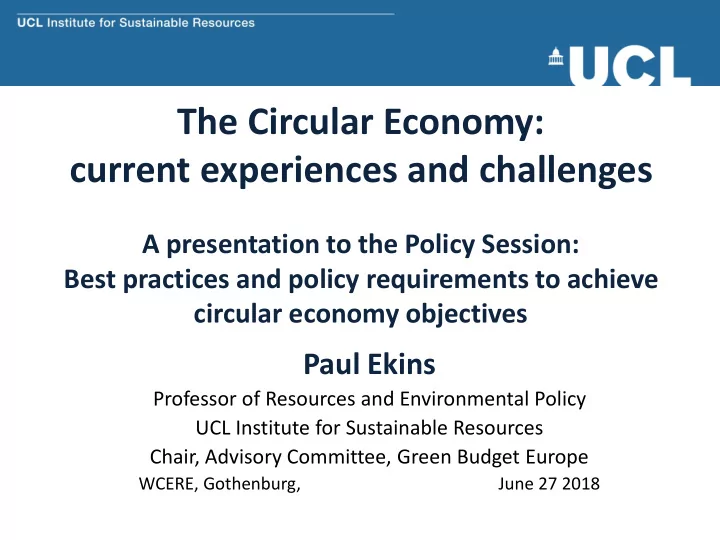

The Circular Economy: current experiences and challenges A presentation to the Policy Session: Best practices and policy requirements to achieve circular economy objectives Paul Ekins Professor of Resources and Environmental Policy UCL Institute for Sustainable Resources Chair, Advisory Committee, Green Budget Europe WCERE, Gothenburg, June 27 2018
Definition of circular economy • WRAP: “ A circular economy is an alternative to a traditional linear economy (make, use, dispose) in which we keep resources in use for as long as possible, extract the maximum value from them whilst in use, then recover and regenerate products and materials at the end of each service life .” (http://www.wrap.org.uk/about-us/about/wrap-and-circular-economy) • Qualifications: economic, thermodynamic, technological • The aim of a circular economy is to maintain the functionality and relative value of materials and products, thereby lengthening the time over which they stay in the economy, or using them more intensively, in order to reduce the inflows of materials into the economy and their associated environmental impacts at extraction or end of life • Related ideas: resource efficiency, resource productivity (cf labour productivity), zero waste, waste hierarchy
The Circular Economy Source: http://www.ellenmacarthurfoundation.org/business/reports/ce2014
EU Circular Economy Package Source: http://ec.europa.eu/environment/circular-economy/ According to the first ‘circular economy package’, turning Europe into a more circular economy means: • boosting recycling and preventing the loss of valuable materials; • creating jobs and economic growth; • showing how new business models, eco-design and industrial symbiosis can move us towards zero-waste; • reducing greenhouse emissions and environmental impacts. A Communication introduced the Package in July 2014. The Package was ‘withdrawn’ by the new Commission in December 2014, with the aim of introducing ‘a broader and more ambitious approach’ in 2015. The new ‘circular economy package’ was introduced in December 2015. The Commission’s website states: “The Circular economy offers an opportunity to reinvent our economy, making it more sustainable and competitive. This will bring benefits for European businesses, industries, and citizens alike. With this new plan to make Europe’s economy cleaner and more competitive, the Commission is delivering ambitious measures to cut resource use, reduce waste and boost recycling.” The plan consists of: • (revised) legislative proposals on waste • an Action Plan on the Circular Economy
Action Plan on the Circular Economy Source: http://ec.europa.eu/environment/circular-economy/ “Closing the loop – An EU action plan for the circular economy” • Production – Product design – Production processes • Consumption • Waste management • From waste to resources: boosting the market for secondary raw materials and water reuse • Priority areas – Plastics – Food waste – Critical raw materials – Construction and demolition – Biomass and bio-based products • Innovation, investment, financing • Monitoring progress towards a circular economy
Policy objectives and instruments for increasing resource productivity (1) • Clear direction of future travel (recycling and efficiency targets) • Extended producer responsibility (materials remain the property and responsibility of the producer) • Product focus – Increase the time material products deliver their service before becoming wastes (product durability, reduced planned obsolescence) – Reduce the quantity of materials required to deliver a particular service (light-weighting) – Increase the amount of information available about what materials are in products, and where (product passports) – Reduce the use of energy and materials required both to produce a product and in its use phase (eco-design, efficiency regulations) – Reduce the use of materials that are hazardous or difficult to recycle of dispose of (substitution) – Design products that are easier to recycle (eco-design)
Policy objectives and instruments for increasing resource productivity (2) • Waste/resource management focus – Make it easier to recycle materials by differentiating between wastes and recyclables (definition of waste, by-products) – Increase the quality of collected recyclates (separate collections) – Create markets for recycled materials through product specifications and green public procurement (standards and regulation) – Ban the incineration of recyclables – Facilitate industrial clusters that exchange materials while they are still resources to prevent them from becoming wastes (industrial symbiosis) • Consumer focus – Require separation of wastes (create recycling habits) – Provide facilities in buildings (make recycling easier) – Incentivise waste reduction and high-quality separation by consumers (e.g. variable waste charging, or Pay As You Throw) – Incentivise separation and collection systems that reduce the costs of recycling and re-use (e.g. deposit-refund schemes)
Action Plan on the Circular Economy (Source: Hugo Schally, DG Environment: presentation to EEA, May 25, 2018; 54 actions covering the whole cycle; 85% delivered, the rest ‘work ongoing’)
Action Plan on the Circular Economy (Source: Hugo Schally, DG Environment: presentation to EEA, May 25, 2018; 54 actions covering the whole cycle; 85% delivered, the rest work ongoing)
The first sign of policy makers taking the full materials cycle seriously – not just externalities
Thank you p.ekins@ucl.ac.uk www.bartlett.ucl.ac.uk/sustainable
Recommend
More recommend